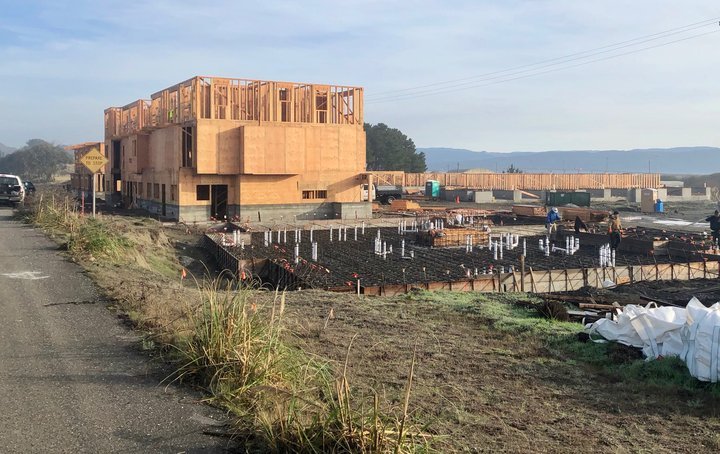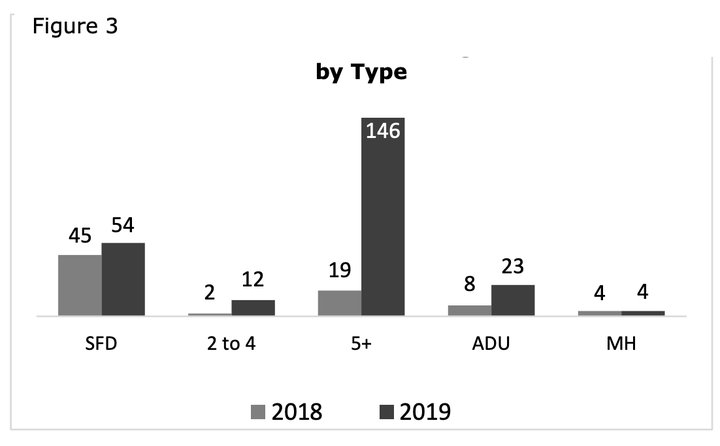
Low-income housing being built by the Danco Group in Samoa. File photo: Ryan Burns.
###
Nearly a year after it was adopted by the Board of Supervisors, the Humboldt County Housing Element has undergone its annual progress report by the Planning and Building Department.
The review, according to a report that was published last week in advance of a planning commission meeting, found good news — the county is making significant progress toward meeting low- and moderate-income housing goals in the unincorporated areas.
Humboldt County adopted its Housing Element for 2019-2027 last August, setting up a framework for how to address housing needs in the unincorporated areas in the coming years. One goal was to establish a new system that eases regulations and other barriers that stand in the way of constructing affordable housing.
“The County’s 2019 Housing Element includes numerous new housing programs that ease regulatory restrictions, move the County from only occupying a regulatory role to a housing facilitator and partner, mandates the creation of new incentives, etc.,” the recent progress report reads. “Essentially, the 2019 Housing Element recognizes the need to additional measures needed to increase housing production across the board.”
The annual report found an increase across the board when it came to the types of housing units being proposed. Single-family units had 190 proposed units in 2019 with only 117 being proposed in 2018. The progress report also saw a significant increase in the number of permits issued for multifamily units, with 146 units permitted in 2019 and 19 in 2018.

Figures 3 indicates the number of issued building permits by type of housing unit. | Courtesy of Humboldt County
John Ford, director of the Planning and Building Department, told the Outpost that the future of affordable housing in Humboldt will largely rest on two issues: a local referendum pursuant to Article 34 of the state constitution, and building Accessory Dwelling Units.
Article 34 of the state constitution limits what local governments can do when it comes to building and financing low-income housing. According to Article 34, local governments may not build or finance these types of projects unless such a program is approved by voters.
“Part of the problem is that we are not producing enough housing that is affordable to lower income households,” Ford said. “That is the need for the Article 34 [referendum], so the county can go out and acquire federal and state money to encourage development of housing that is more affordable. That is a centerpiece of what we are trying to do right now as we implement the 2019-2027 Housing Element.”
Ford said the Article 34 referendum is the bulk of the focus of work right now, and that there will be an agenda item on the July 7 Board of Supervisors’ meeting discussing it and whether or not it will be placed on the Nov. 3 ballot.
When it comes to “accessory dwelling units” — mother-in-law units and the like — Ford said the progress report found a significant increase in proposals, which the Department attributed to a growing awareness amongst the public. In 2019, 71 ADUs were proposed, which is more than double the amount from 2018 (33). One of the things the county is doing to promote the building of ADUs is changing the code to allow up to three ADUs per parcel — two regular-sized ADUs and a Junior ADU.
“What that does is, by design, lowers the cost of those ADUs, because the land cost doesn’t exist there — it is just the construction cost at that point,” Ford said. “And so the rental rate for those could be far lower and it provides a reasonable amount of income for a property owner who wishes to do that. So we are working hard to get that done, with the thought that it is probably our most viable form of providing affordable housing, by making the ability to construct ADUs a reality for as many homeowners as possible.”
On the large-scale housing projects, a significant increase in units is attributed to the Danco Group. In 2019, 79 very low-income units were permitted, and all of them went to a single Danco project — the Samoa Vance Apartments. Ford praised Danco’s work when it comes to building these units.
“They are really occupying a niche in the housing market where they are able to put together grants and funding mechanisms to build housing that is affordable, and this is not their first foray into this,” Ford said.
Chris Dart, the president of Danco Communities, told the Outpost that the Samoa Vance Apartments project, which is due to be completed by the end of the year, will consist of one- to four-room apartments, each with a garage — because they are being built in a tsunami inundation zone, which forces developers to build living units a certain height above a possible high water mark.
“As a result of that, people get a garage out of it, which is pretty unique,” Dart told the Outpost. “Usually, housing like this, people would park just outside and walk to their apartment, but in this case each unit has its own garage.”
One of the reasons why some developers may choose not to build low-income housing is because the profit margins aren’t as large as single-family homes. But Dart said low-income housing projects, like the Samoa one, are still profitable for Danco, and they have built 24 low-income projects consisting of about 700 units across the county.
To help fund some of these projects, Danco has a team dedicated to pursuing state and federal grants. Dart said there are three people solely focused on finding and securing grants from the California Department of Housing and Development, the California Tax Credit Allocation Committee, the US Department of of Agriculture’s Rural Housing Department, among others.
“I don’t know if you knew this, but the USDA is in the housing business as well,” he said with a laugh.
Danco also streamlines their process with the design, construction, grant searching and property management all falling under one roof. Danco recently finished a housing project in Eureka on Fourth Street for those experiencing homelessness. He said the new site has a project-based Section 8 housing voucher system. He also said a certain number of the units at the new Samoa project will be set aside specifically for homeless families, 10 two-bedrooms and 10 three-bedrooms.
“Sadly, there are families on the street without a home … ,” Dart said, “and so we have set aside 20 units for those families in Humboldt that are currently experiencing homelessness.”
CLICK TO MANAGE